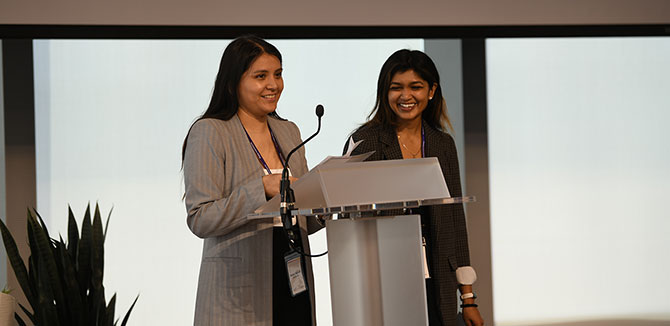Learning to Lead the Kellogg Design Challenge
The annual event's co-chairs reflected on the design competition and what they learned about leadership from the experience.

The Kellogg Design Challenge (KDC) is the largest business design case competition across MBA programs in the world.
The event is hosted by the Kellogg Innovation and Design Association (IDEA) club, which features a number of members from Northwestern's MBA + MS in Design Innovation (MMM) program — a dual-degree program between Northwestern Engineering and the Kellogg School of Management.
This year's event, sponsored by MMM and the Segal Design Institute, featured an expanded scope, with more than 110 participants, judges, and speakers traveling to Evanston to participate. There were three pre-event workshops on consumer listening, prototyping, and ethical artificial intelligence. There were also three breakout sessions and two keynote lectures as part of the event.
Sixteen semi-finalist teams representing eight graduate schools competed in the competition.
New additions to this year's event included:
- The first sponsor challenge theme, which was AI x Design; Hyster-Yale Group representatives came up with the theme and helped judge the competition
- Project collaborations between students from MMM and Northwestern's Engineering Design Innovation (EDI) program
- An award for excellence in equity-centered design
A team from Cornell took first place in the competition. Team Medium, featuring three MMM students and two EDI students, finished in second place and earned a $5,000 prize.
KDC co-chairs Farah Imtiaz (MMM '24) and Su Salinas reflected on the event and what they learned about leadership from the experience.
Why did you want to take on a leadership role with KDC this year?
Salinas: I wanted to engage in something that was a more challenging, professional experience. KDC involves working with sponsors, getting to know MBA students from across the globe, and leading a team. It was a significant leadership opportunity.
Imtiaz: I wanted to reconnect with my passion for design. As IDEA’s marquee event, KDC was a way for me to make a significant impact in a meaningful way. Throughout MMM, I've learned about — and from — some of Northwestern's best design doers and thinkers, and I wanted to provide a platform for people to learn and demonstrate their skills.
What was your goal and strategy for this year's KDC?
Salinas: We aimed to push the boundaries of what KDC could be this year. We started by reviewing feedback from last year's event to understand the challenges and opportunities for the next year. This set the baseline for what we wanted to accomplish. Additionally, we wanted to consider the end-to-end experience not only for the participants but also for the sponsors and the KDC team.
Imtiaz: Our goal was to ensure that KDC inspires, challenges, and leaves participants feeling accomplished, regardless of their design background. We aimed to foster meaningful connections and ensure the event was enjoyable for everyone involved.
How did you introduce more connection, collaboration, and creativity to the event?
Salinas: We wanted to create more spaces for the teams to get to know one another outside of the competition, so we hosted a pre-event mixer and post-event reception. We also collaborated with the University of Chicago Booth School of Business for the first time to host a KDC after party in Chicago.
Imtiaz: In terms of programming, we hosted workshops on design research, prototyping, and ethical AI that encouraged our participants to explore new technologies and considerations as they developed their solutions. To spur fun and creativity during the event, we hosted a “KDC Photo Challenge'' in our WhatsApp group that encouraged teams to take and submit goofy photos together.
In design thinking, we frequently use the Desirability-Viability-Feasibility (DVF) framework to evaluate initiatives. We wanted to make sure that KDC not only hit DVF, but also considered another measure: sustainability. For us, that meant making sure that we pushed participants towards solutions with longevity and that were built for everyone. This inspired events like the discussion around Ethical AI with Professor Adam Waytz and the Excellence in Equity-Centered Design Prize.
What were the most important lessons you learned as an event organizer?
Salinas: It’s crucial to find a partner whose abilities and skills complement your own and who can back you up. My favorite compliment at the end of KDC was that our team worked cohesively together on the day of the challenge — we were always there supporting one another. This highlighted for me how KDC would not have been possible without the incredible team behind us.Imtiaz: Intentionally designing the KDC team’s experience was very important for me. I wanted to make sure that each team member felt valued, prepared, and critical in their contributions. As we moved through planning, I learned the importance of positivity and adaptability in leadership styles. For example, I spent time testing and learning what the right level of strategy and direction were for our team members to balance ownership, transparency, and time constraints.
